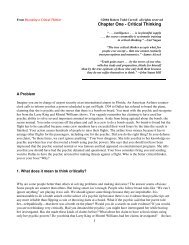A Practical Guide to Critical Thinking - The Skeptic's Dictionary
A Practical Guide to Critical Thinking - The Skeptic's Dictionary
A Practical Guide to Critical Thinking - The Skeptic's Dictionary
You also want an ePaper? Increase the reach of your titles
YUMPU automatically turns print PDFs into web optimized ePapers that Google loves.
Greg R. Haskins<br />
6<br />
Step 3: Identify & Characterize Arguments<br />
At the heart of critical thinking is the ability <strong>to</strong> recognize, construct, and evaluate<br />
arguments. <strong>The</strong> word argument may be misleading <strong>to</strong> some. It does not mean <strong>to</strong><br />
quarrel, complain, or disagree, even though the word is often used informally in that<br />
context. In the context of critical thinking, an argument means the presentation of a<br />
reason(s) <strong>to</strong> support a conclusion(s), or:<br />
Argument = Reason + Conclusion<br />
<strong>The</strong>re must be one or more reason statements and one or more conclusion statements<br />
in every argument. Depending on usage and context, reasons are synonymous with:<br />
premises, evidence, data, propositions, proofs, and verification. Again, depending on<br />
usage and context, conclusions are synonymous with: claims, actions, verdicts,<br />
propositions, and opinions.<br />
A critical thinker must learn <strong>to</strong> pick out arguments from verbal or written communication.<br />
Sometimes arguments will have indica<strong>to</strong>rs such as ‘since’, ‘because’, ‘for’, ‘for the<br />
reason that’, and ‘as indicated by’ <strong>to</strong> separate the conclusion statement(s) from the<br />
reason statement(s) that follows (see above example). At other times, arguments will<br />
have indica<strong>to</strong>rs such as ‘therefore’, ‘thus’, ‘so’, ‘hence’, and ‘it follows that’ <strong>to</strong> separate<br />
the reason statement(s) from the conclusion statement(s) that follows. In some cases<br />
there will be no indica<strong>to</strong>r words at all; the context alone will indicate if a statement is<br />
intended as a reason, a conclusion, or neither.<br />
Formal logic divides arguments in<strong>to</strong> inductive and deductive arguments. While critical<br />
thinking is an informal application of logic, the critical thinker should at least understand<br />
the fundamental differences between the two forms. If one thing follows necessarily<br />
from another, this implies a deductive argument. In other words, a deductive argument<br />
exists when ‘B’ may be logically and necessarily inferred from ‘A.’ For example, if one<br />
makes the statement “All bachelors are unmarried (‘A’)” and “John is a bachelor (‘B’)”,<br />
then one can deductively reach the conclusion that John must be unmarried.<br />
However, most arguments that one encounters in daily life are inductive. Unlike<br />
deductive arguments, inductive arguments are not ‘black and white’, because they do<br />
not prove their conclusions with necessity. Instead, they are based on reasonable<br />
grounds for their conclusion. A critical thinker should understand that no matter how<br />
strong the evidence in support of an inductive argument, it will never prove its conclusion<br />
by following with necessity or with absolute certainty. Instead, an inductive argument<br />
provides only proof <strong>to</strong> a degree of probability or certainty.<br />
Arguments presented by courtroom at<strong>to</strong>rneys are good examples of inductive<br />
arguments, whereupon a defendant must be found guilty beyond a reasonable doubt<br />
(equivalent <strong>to</strong> reasonable grounds). It is always possible that an inductive argument that<br />
has sound reasons will have an erroneous conclusion. For example, even though a jury<br />
finds a defendant guilty beyond a reasonable doubt, there is always a possibility (even if<br />
remote) that the defendant had not committed the crime. <strong>The</strong> critical thinker should<br />
assess the cogency of inductive arguments in terms of degrees of certainty instead of<br />
absolute ‘right & wrong’ or ‘black &white’. This applies even if a ‘yes/no’ or ‘either/or’<br />
decision must be made or judgment must be rendered on the argument.






